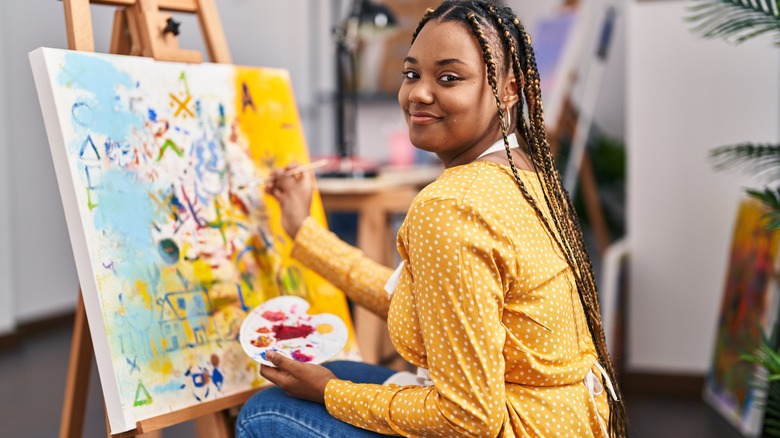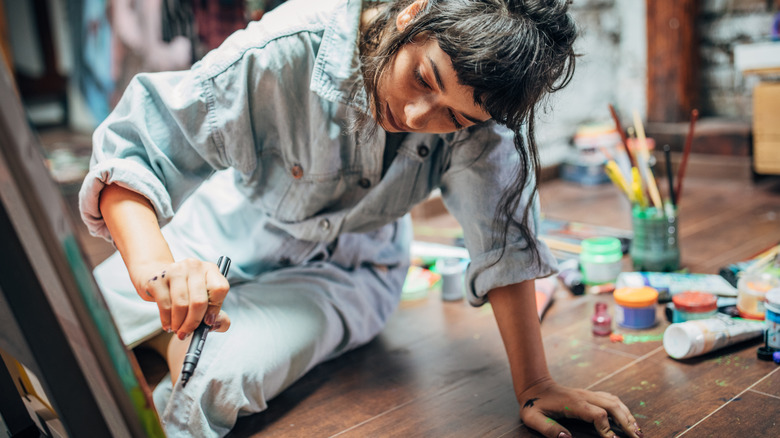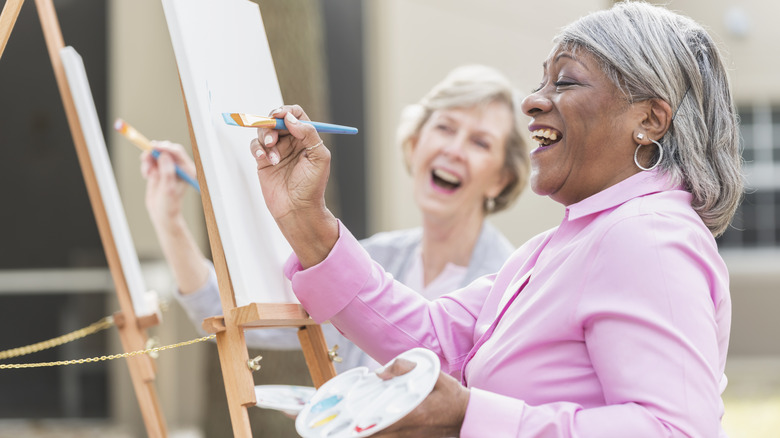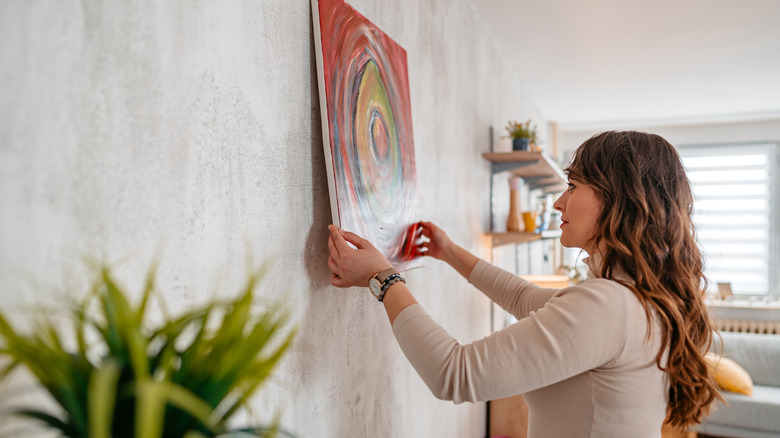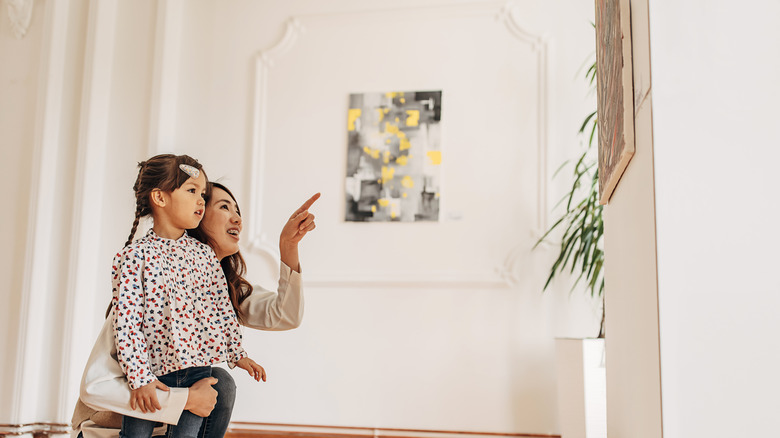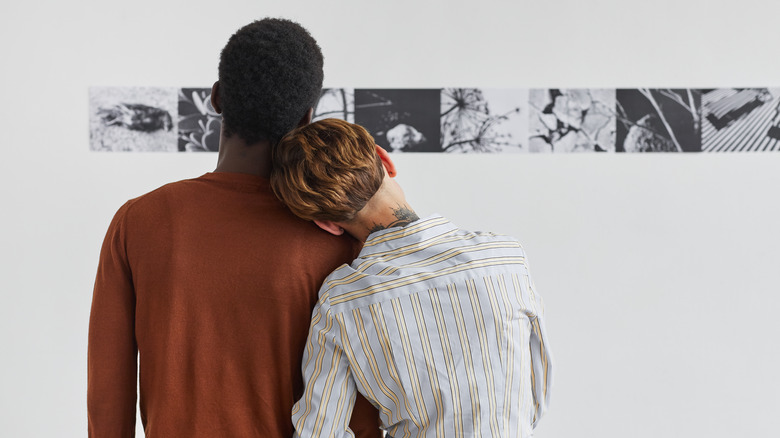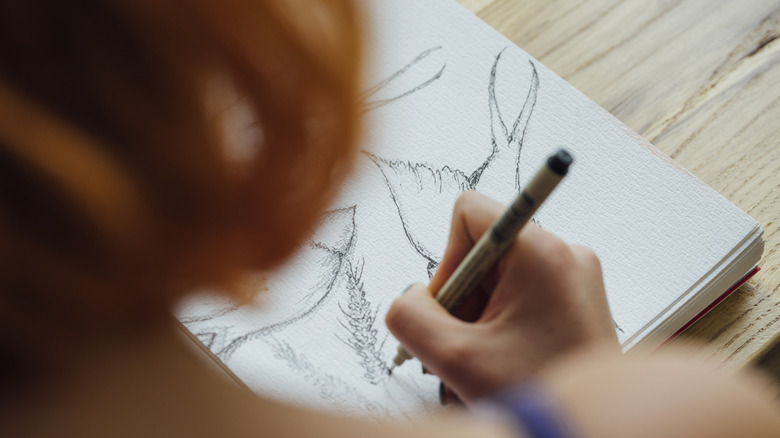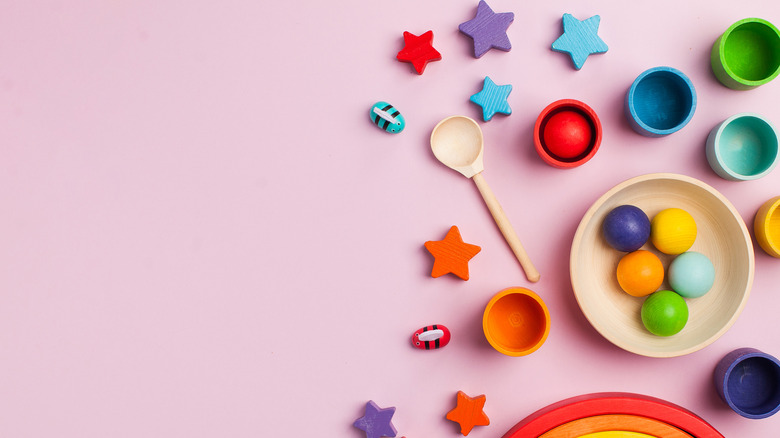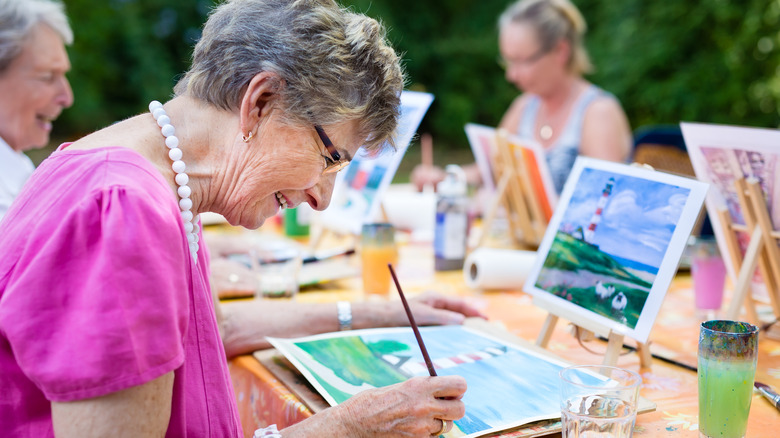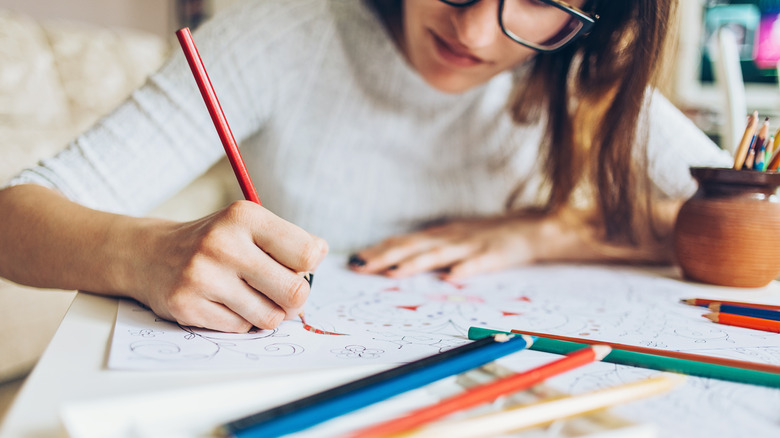10 Ways Letting Your Inner Artist Out Can Improve Your Well-Being
Right off the bat, you should dispel the idea that art is reserved for creative and artistic folks. As humans, creating art is an innate trait, much like language or making music. We've been creating most forms of art for about 17,000 years, with two-dimensional and three-dimensional images dating back as far as 40,000 years (via the Smithsonian National Museum of Natural History).
Excitingly, there are many art forms and mediums available. You can start with something simple, like doodling, or explore digital apps for creating designs. Collaging is a great way to document your experiences or depict your mood. If you can afford art supplies, you can take up drawing, painting, or modeling with clay. Alternatively, you can play around with household items and tools. You can also start a craft like knitting. Finally, if creating art isn't your jam, try exposing yourself to art by visiting a museum or an exhibition, or getting some art pieces for yourself.
The options for engaging with art are endless, and the physical and mental health benefits of the hobby are just as appealing. Everyone has an inner artist waiting to be set free, and doing just that might be what you need to improve your well-being. The World Health Organization noted that making or enjoying art promotes holistic wellness, can reduce disease risk, and can aid with illness recovery. But the potential payoffs don't stop there.
You can understand and express your emotions
Art has the ability to evoke emotions. By viewing art, you can experience a range of emotions, including excitement, love, hope, sadness, despair, or sorrow. Sometimes, you may not be able to express what you feel with words. Research published in the International Journal of Environmental Research and Public Health noted that there are many theories for why music and art evoke emotions, both good and bad. But, irrespective of the kind of emotions it prompts, good art creates a positive experience and improves well-being.
Creating art can also serve as an emotional outlet, especially for those emotions that are hard to communicate. A study published in Cogent Arts & Humanities explained that as part of the process of making art, you can understand, analyze, and even alter your emotions. In the study, participants expressed their emotions by creating works of art. Subsequently, they worked through their emotions with the assistance of researchers. The researchers found that the participants were able to interpret their emotions by explaining what certain symbols in their art meant to them.
Anyone can express their emotions through drawing, painting, doodling, or any form of art. The Arts Academy in the Woods advised that it is important to let your emotions guide you when making art. You should embrace the creative process and not be afraid of making mistakes, your skill level, or breaking any rules.
You can unlock your flow
It is common to hear about musicians, artists, and writers "finding their flow." However, you do necessarily need a creative title to experience flow. You can get in the zone or find your flow while doing your job, playing a game, or doing sports.
As described by an article published in Frontiers in Psychology, experiencing flow can convey a "sense of having stepped out of the routines of everyday life into a different reality." In this state, you become laser-focused, lose your sense of time, your mind does not wander, and you are likely to be less in your head. If you find your flow while making art, you may notice that there is no specific direction or goal in mind. You literally go with the flow and watch what you create. The beauty of being in the zone is that it is spontaneous and takes no effort.
While it might not seem like a big deal, the "deep engagement" that comes with flow may confer notable benefits, according to the Journal of Positive Psychology. This engagement is associated with feeling more competent and satisfied with life. Overall, experiencing flow can be rewarding, and doing so frequently is associated with better well-being. The paper noted that people with certain traits, like curiosity, motivation, and enjoyment of challenges, tend to access flow more than others. However, flow usually unfolds when your skills match a challenge. So, if your skills match the challenge of creating art, you could experience flow while making art.
Art can help you relax when you feel stressed or anxious
If you're feeling particularly stressed or anxious, it might be a good time to let your inner artist out. A study published in the Journal of the American Art Therapy Association found that making art for just 45 minutes can reduce levels of the stress hormone cortisol, regardless of artistic skill. The participants also reported finding the art-making session "relaxing, enjoyable, helpful for learning about new aspects of self, [and] freeing from constraints," and were able to lose themselves in the work. Another study published in PLoS One found that art therapy can reduce anxiety levels by regulating stress, particularly among women.
Simple activities like cracking open a coloring book or doodling can help you relax, according to Room for Art. For an extra shot of calm, try painting or drawing to music or the sound of moving water. Making soft sculptures can also help you relax. To do this, you'll need a soft object like a stuffed sock. Manipulate the sock into any shape and secure it by tying it with a ribbon or a similar option. The soft sculpture can even serve as a stress ball that you can knead and squish, as noted by artist Sally Price.
Creating art can boost your self-esteem and provide a sense of reward
Creating art is a great way to boost your self-esteem. Research published in the Annals of the New York Academy of Sciences showed that children who regularly participated in creative activities had higher self-esteem at age 11 compared to other children. The authors suggested that this may have happened because art emphasizes the uniqueness of individual children, in part because of the level of skill acquired through its creation.
Art can also give you a confidence boost as an adult. Losing yourself in art can help you alleviate negative feelings (via Art from the Streets). Additionally, building your artistic skills can give you a sense of elation. If you decide to show your work to others, you may receive compliments or even sell your pieces, which can do wonders for your self-esteem.
Creating art can be rewarding in and of itself. A study published in the Arts in Psychotherapy measured the brain activity of a small sample of artists and non-artists while they colored, doodled, and drew freely. Results showed that all forms of art-making increased the activity of the medial prefrontal cortex of the brain in both artists and non-artists. This area is believed to be part of the brain's reward system (per Amino Acids), which is activated when the brain perceives something as enjoyable and worth doing again. Additionally, creating art improved how the participants perceived their ability to "[have] good ideas and [be] able to solve problems."
Art can elevate your mood
Have you ever looked at a piece of art, perhaps in a museum, an exhibition, or a restaurant, and just felt a little lighter? Well, it turns out that not just physical art, but digital art as well can have a similar effect, as evidenced in a study published in Computers in Human Behavior. Participants in the study viewed a digital art exhibition for a short period, and the results showed a general improvement in their mood. The study further found that these improvements were linked to how often an individual has meaningful and pleasurable experiences. The authors proposed that seeking such experiences, whether at museums or by looking at digital art, architectural designs, or natural scenery might improve well-being.
In addition, creating art can improve your mood. One study published in Arts & Health observed that a brief session of free art-making among healthy adults increased positive mood and reduced negative mood in most of the participants. The participants were asked to use either collage materials, modeling clay, or markers to make an expressive piece, and their mood was evaluated with questionnaires prior to and after the session. From the study, changes in mood did not depend on prior experience making art. These changes also correlated with improvements in perceived self-efficacy: their belief in their ability to accomplish something (per American Psychological Association).
You can bond with other people through art
Engaging with art can provide an avenue for connecting with others. A study published in BMC Public Health surveyed 5,892 U.K. adults about how they made social connections through art. Participants reported experiencing art through visits to movie theaters, exhibitions, museums, or galleries, attending live theater or musical performances, or reading. The researchers discovered that engaging with art gave participants an opportunity to meet and interact with new people. They developed shared experiences and got closer to others through art. These activities also "[facilitated] collective understanding" and fostered a sense of belonging, even among people who were not close.
Viewing artists' pieces can also help you connect with and understand them. A paper published in Behavioral Sciences explained that art may activate mirror neurons in the brain. These neurons mirror what you see others doing as if you were doing it, or things happening to others as if they were happening to you. The mirror system serves as the brain's empathy device, and it could be part of the system that helps you understand and feel intense emotions when you look at some forms of art.
If you want to remember something, draw it
Your pen and paper can be used for something more creative when you have lots of information to remember: drawing. You may have a better chance of remembering complex information for an exam or a list of talking points for a presentation by getting creative and drawing them out.
In a study published in the Quarterly Journal of Experimental Psychology, researchers named this phenomenon "the drawing effect." They conducted a series of experiments to determine if drawing freely is a better mnemonic strategy than writing. Their results showed that drawing pictures of words helped participants remember those words better than only writing them out once or repeatedly.
To explain why drawing is a better way to recall, the researchers proposed that when you draw, you have to consider the physical attributes of an item and how it should look and create a picture by moving your hands. This picture leaves a mental image. All these steps you've taken to draw the picture–your assessment of the item, your hand movements, and the final picture–are actually stored as memory. Because of this, the mental image of the picture you've drawn is a lot easier to recall. With other strategies like only writing, viewing a picture, or visualizing an image, you don't store the memory in as many ways. This makes you less likely to remember than when you draw.
You can learn through art
Making art is not only a means of remembering, it is also a way to learn new things. This does not require mastering art history or developing top-level artistic techniques, but rather using art as a learning tool. According to a review published in Frontiers in Psychology, art-based learning can boost the learning process of any subject. This can include the use of music or theater. Interacting with art can evoke pleasure, improve mood, promote positive emotions, and confer a sense of reward. In this state, you're more likely to learn something new.
One popular method for using art to learn is to use pictures or art pieces as learning aids. You could also sketch diagrams or illustrations while taking notes. To organize complex ideas, try creating collages instead of feeling overwhelmed by information. Simple clay models can bring abstract ideas to life and give them meaning. Other art forms, such as acting out a topic or using music to help break down or memorize complex ideas, are also effective (via National Education Association).
Making art can aid your recovery from a health challenge
In addition to established treatments, making or viewing art can serve as supplementary therapy for health challenges, especially chronic illnesses. Art can address the physical and non-physical effects of living with an illness, promoting a more holistic approach to disease recovery.
A review published in the American Journal of Public Health explored the different ways art can aid disease recovery or alleviate the burden of illness. For example, art can induce relaxation and can elevate mood, helping to alleviate stress and depression among individuals with chronic illnesses. Art can also provide a means of expression or escape for tough emotions such as distress, fear, anger, guilt, or pain associated with being diagnosed with a chronic illness. Through art, individuals can tell their own story of what having a particular illness means to them. By creating something, they can improve their self-worth and separate their identity from an illness.
You can use art for self-care
Self-care involves many activities, from getting a relaxing massage to reading a book. Generally, any activity that takes care of your physical or mental well-being can be considered self-care. Ideally, you should use self-care to reduce stress, express your emotions, or build healthier habits (via the National Institute of Mental Health). Making or viewing art can serve as self-care since it ticks many of the boxes of self-care activity.
Art can help you feel more connected to yourself. It allows you to slow down and pay attention to yourself and the little details around you. As registered art therapist Natalie Foster noted to Psych Central, "[Art] can show us our pain in a heartbeat, and it also can give us clues to what we are needing, and what direction to take in the present moment."
There are many ways to use art for self-care. For instance, drawing, painting, or collaging can serve as emotional outlets. You can also create a scrapbook or an art journal to document your everyday life. And who says self-care needs to be a solo act? Host an art party so you can decompress and share with others.
